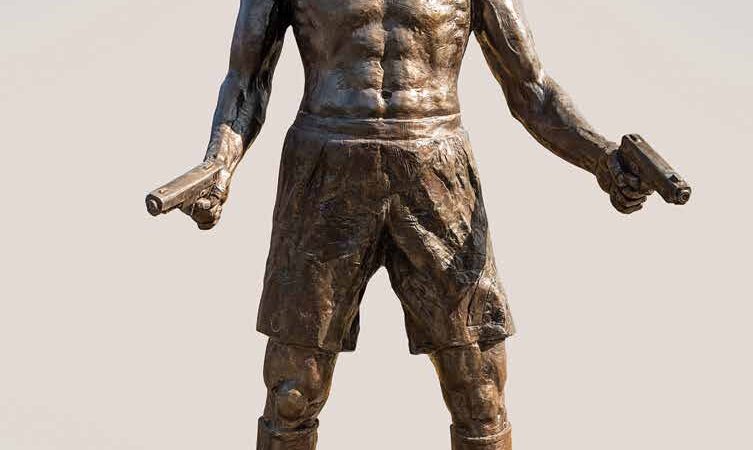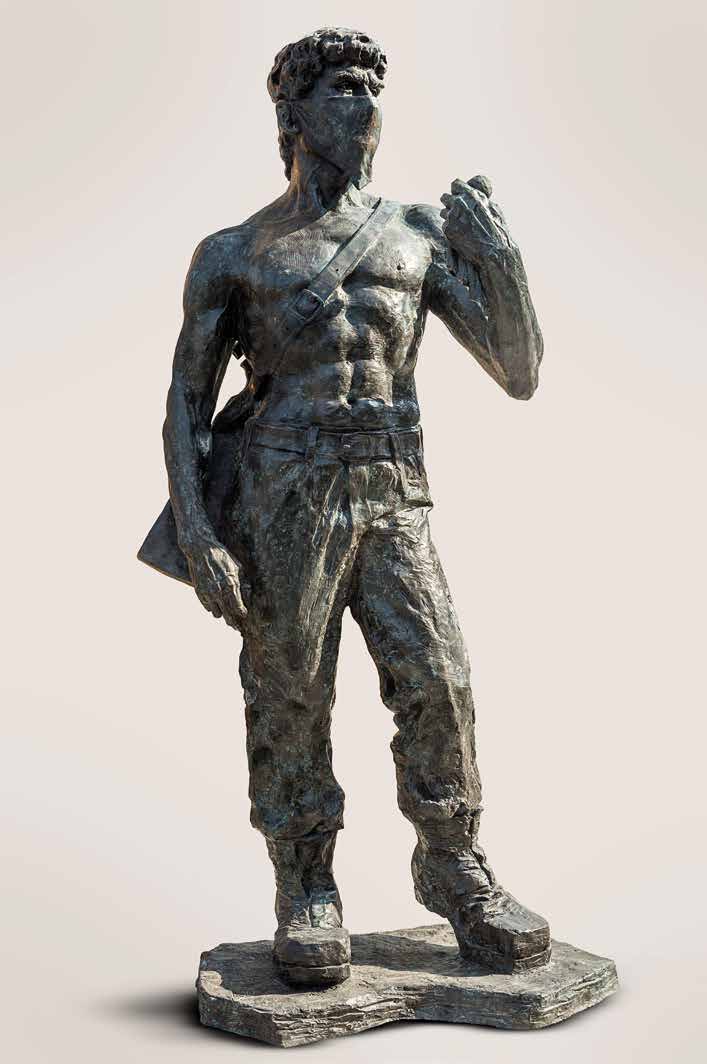
Ahmed Al Bahrani | Sculpting Stories in Metal at Nader Sculpture Park
By Maria Caro Alonso, Nader Sculpture Park
Why is Mother Teresa holding a weapon? Why do Picasso, Ronaldo, Mandela, and Gandhi appear in War to War with a symbol of violence in their hands? In his provocative series exhibited at Nader Sculpture Park, Ahmed Al Bahrani challenges the narratives we take for granted. With his masterful command of metal, the artist forces us to look again, to question how power, war, and peace intertwine throughout history. Who decides what makes a hero or a villain? How many versions of history exist? Through the weight of bronze and the hardness of steel, Al Bahrani not only sculpts figures but also cracks open the way we interpret the past and present
Al Bahrani’s sculptures are more than mere structures; they are dialogues between history, material, and form. By utilizing enduring materials like bronze, aluminum, and steel, he explores themes of time, transformation, and permanence. His works often reflect a balance between strength and fragility, structure and erosion, inviting viewers to observe, reflect, and engage with the embedded stories. His fascination lies in how objects and symbols carry meaning, evolve, and remain significant over time.

An In-Depth Conversation with Ahmed Al Bahrani
Q: Your work is a dialogue between history, material, and form. How do you use metal to explore themes of time, transformation, and permanence?
Al Bahrani: “Metal—whether bronze, aluminum, or steel—is both a challenge and a reward. It is a material of endurance, capable of withstanding time while also being shaped by it. It allows me to work with contrasts: smooth and rough surfaces, polished and corroded textures, weight and lightness. The transformation of raw metal into something expressive and dynamic is what keeps me engaged with this medium.”
Q: How important is the environment in which your sculptures are placed?
Al Bahrani: “A sculpture is never just an object—it exists within a space, and that space affects how it is perceived. Whether placed in a gallery, a public square, or the middle of a desert, my work interacts with its surroundings. The light, the weather, the people passing by—all of these elements shape the sculpture’s meaning and impact.”
Q: What has been the most remote location where your work has been exhibited, and how did that setting influence the reception of your art?
Al Bahrani: “Every location brings something new to the work, but I was particularly intrigued when my Sheikh Tamim Anti-Corruption Hand Sculpture was installed in Rwanda. The themes of justice and integrity resonated deeply in that setting. Similarly, placing my sculptures in Miami allowed me to introduce my work to a broader international audience, engaging in conversations that extend beyond geographical borders.”
Q: What new dimensions or themes would you like to explore in future sculptures?
Al Bahrani: “I am entering a phase in my work where I am more deeply exploring the philosophy of material and memory—how objects, over time, gain meaning beyond their physical form. I am interested in how metal, a material often associated with permanence, also carries traces of transformation, decay, and renewal. My focus is shifting toward the ways in which objects hold collective memory, how they evolve through history, and how they acquire significance through the people who interact with them. I want to create sculptures that challenge the viewer to consider not just what they see, but what the material itself has witnessed.”
Q: The Nader Sculpture Park welcomes both locals and tourists. How do you think your work will resonate with these dif erent audiences, and what message would you like visitors to take away after viewing your sculptures?
Al Bahrani: “My work speaks across cultures because it is rooted in human experience. I would want visitors to feel something—whether it is nostalgia, reflection, or an understanding of resilience. I hope my sculptures at the park will serve as bridges between different perspectives, creating conversations that extend beyond the moment of viewing.”
Q: How would you guide visitors in interpreting the emotions or feelings that your sculptures might evoke? Is it important to you that people feel something specific when viewing your works?
Al Bahrani: “I do not believe in dictating emotions. Art should leave a space for personal interpretations. That being said, I craft work with a deep emotional intent—whether it is sorrow, strength, or irony. A true engagement with art happens when a person reflects on what they see and how it speaks to them.”
Q: Do you consider there to be an “ideal” way to approach a sculpture, such as walking around it in a particular direction or viewing it from certain angles first?
Al Bahrani: “A sculpture is meant to be experienced from all angles. A single viewpoint does not tell the whole story, but I do encourage viewers to move around and engage with the piece naturally. To observe how shadows shift and how light interacts with the textures and contrasts of the sculptures.”
Q: Would you include any clues or hints to help visitors discover hidden meanings or personal interpretations of your sculptures?
Al Bahrani: “Yes, but subtly. I often embed textures, inscriptions, or distorted details that invite closer inspection. Some of these are inspired by history, some by personal memories, and some are meant to challenge the viewer to look deeper.”
Q: Do you believe there is a rhythm or patience necessary to fully enjoy your sculptures?
Al Bahrani: “Absolutely. The layers of meaning embedded in my work do not reveal themselves at first glance. The more time you spend with it, the more you discover—whether it’s the details of the surface, the balance of the composition, or the contrast between materials.”
